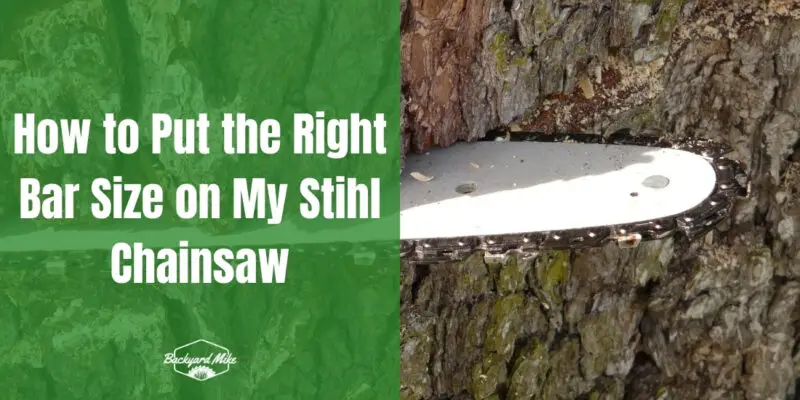To put the right bar size on your Stihl chainsaw, first determine the mount size: small, medium, or large. Measure the mount slot using a caliper for accurate fit. Check your chainsaw model to confirm the bar's length and pitch, like 3/8", are compatible. Choose a chain with the correct gauge, like 0.050", matching your bar and sprocket. Following these steps guarantees peak performance and safety, and there's more to discover.
Key Takeaways
- Identify your Stihl chainsaw's mount size to ensure the correct bar fit, using a caliper for precise measurements.
- Confirm the bar's pitch and gauge match your chainsaw's sprocket and chain for compatibility.
- Choose a bar length suitable for your tasks, such as shorter bars for precision or longer bars for heavy-duty work.
- Refer to your Stihl chainsaw's manual for recommended bar sizes and specifications to ensure proper performance.
- Regularly inspect and maintain your bar for wear, ensuring optimal chain tension and lubrication for reliable operation.
Understanding Stihl Mount Sizes
When you're working with Stihl chainsaws, understanding the different mount sizes is key to ensuring you select the right guide bar for your tool.
Stihl chainsaws use small, medium, and large mount sizes, each with specific measurements. Familiarize yourself with these mount sizes to make informed decisions. The medium mount size, 3003, is widely used, offering bar interchangeability tips across various models. This interchangeability simplifies your task, letting you swap bars between compatible chainsaws easily. Use a caliper to measure the mount slot width accurately and compare it with the Stihl mount table for precise fitment. It's important to note that both Husqvarna and Stihl offer durability and performance in their chainsaws, making them popular choices among users.
Remember, the small mount size, 3005, and the large, 3002, cater to particular needs, so knowing these specifications aids in mount size comparison.
Always check your chainsaw's model to match the correct mount size, ensuring peak performance and avoiding fitting issues.
Identifying the Correct Bar Specifications
To select the correct bar specifications for your Stihl chainsaw, start by considering the bar length and pitch, which vary based on your model and intended tasks. Shorter bars, like 10" or 12", are ideal for precision work, while 16" or 18" bars handle heavier tasks better. Additionally, verify the chain gauge and drive link count match your bar to maintain proper fit and peak performance. It's crucial to properly match the bar and chain specifications to ensure the chainsaw functions safely and effectively. Stihl chainsaws are known for their anti-vibration system, which reduces user fatigue and enhances control, making it important to choose a compatible bar that aligns with these ergonomic designs.
Bar Length and Pitch
Choosing the right bar length and pitch for your Stihl chainsaw is essential for peak performance and safety.
Start by verifying bar compatibility with your specific chainsaw model. Stihl bars are often compatible with Oregon guide bars, making it easier to find the right fit.
Consider the cutting efficiency required for your tasks; longer bars, like 18" or 20", are suited for larger logs, while 12" or 14" bars work well for smaller tasks. When selecting a chainsaw, it's important to consider safety features such as anti-kickback chains and anti-vibration systems to reduce the risk of accidents.
For pitch, common choices include 0.325" and 3/8", with Stihl frequently using 3/8" for superior performance. Stihl chains have numbers stamped on the side indicating specifications, helping users to identify the correct pitch and gauge for their chainsaw.
Confirm the pitch matches your saw's sprocket for proper chain fit.
Chain Gauge and Links
After selecting the appropriate bar length and pitch for your Stihl chainsaw, it's important to focus on the chain gauge and links to confirm peak performance and safety. The chain gauge, commonly 0.050", 0.058", or 0.043", determines how well the chain fits on the bar. A correct gauge enhances durability and minimizes accident risks. Count the drive links on your current chain to verify the new chain fits perfectly. Each chainsaw model may require a specific number of links for maximum performance. Consult your Stihl manual for guidance on chain specifications. Using the correct specifications guarantees your chainsaw functions effectively, enhancing safety and longevity. Stihl chainsaws offer multiple configurations for different bar lengths to ensure compatibility and performance. Your local dealer can provide professional advice tailored to your needs.
Selecting the Appropriate Chain for Your Bar
Selecting the right chain for your Stihl chainsaw's bar is essential for ideal performance and safety. Understanding chain types and job requirements helps you choose effectively. Here's how to match your chain to the task:
- Firewood and Light Duty: Opt for low-profile or semi-chisel chains due to their reduced kickback and ease of use.
- Professional Logging: Full chisel chains provide speed and efficiency for cutting hardwood.
- Mixed Wood Conditions: Use semi-chisel chains as they maintain sharpness longer across various wood types.
- Dirty Conditions: Semi-chisel chains are durable, requiring less maintenance in dusty environments.
When selecting a chain, ensure that the pitch matches the chainsaw guide bar and drive sprocket for proper fit. Always check your chainsaw model's compatibility with the chain's pitch, gauge, and drive links.
Consult your user manual or a STIHL dealer for personalized advice.
Ensuring Safety With Proper Bar and Chain Fit
To guarantee safety with your Stihl chainsaw, start by choosing a bar size that's compatible with your saw's powerhead. The STIHL ROLLOMATIC E Super guide bar is made from high-grade steel, which ensures durability and reliability. Match the chain specifications precisely to the bar and powerhead to maintain peak performance and reduce risks. Follow safety guidelines diligently, including using protective gear and regularly checking for wear and proper tension.
Choose Compatible Bar Size
When choosing the right bar size for your Stihl chainsaw, it's essential to confirm compatibility with the engine's power to avoid overloading and damage. Verifying bar compatibility enhances chainsaw performance and safety. Consider these key points:
- Engine Power Compatibility: Match the bar size to your chainsaw's engine power to confirm efficient operation without overloading. For example, 50 gauge bar and chain are more durable and longer-lasting than other options.
- Bar Length Flexibility: Stihl offers bars ranging from 16" to 59", allowing you to select the appropriate length for your specific tasks.
- Sprocket Compatibility: Make sure the bar fits the type of sprocket, like a rim sprocket, for smooth function.
- Guide Bar Materials: Opt for durable materials, such as high-grade steel, to reduce wear and extend the bar's lifespan.
Match Chain Specifications Precisely
Confirming the right bar size is just the start; getting the chain specifications right is equally important to guarantee safe and efficient operation.
Start by identifying your chainsaw model, such as MS 170 or MS 250, and consult the user manual. Match the chain pitch and drive link gauge precisely to your guide bar specifications. This alignment prevents compatibility issues. Full Chisel Chains, for example, offer fast cuts but require more maintenance and are prone to dulling, making them suitable for professionals.
Count the drive links accurately, as they determine the chain loop length, ensuring it fits your bar perfectly. Choose the chain type—Picco, Semi-Chisel, or Full Chisel—that suits your cutting tasks and experience level.
A precise match of chain specifications reduces kickback risks, ensuring safer operation. If in doubt, consult a dealer for verification, as precision is key to safety.
Follow Safety Guidelines Religiously
Always prioritize safety by following guidelines meticulously when using a chainsaw. Safety awareness and proper maintenance guarantee your chainsaw operates efficiently and safely. Here's how you can achieve that:
- Read Safety Manuals: Familiarize yourself with the instruction and safety manuals. If lost, they're often available online.
- Wear Proper PPE: Don necessary personal protective equipment every time you operate your chainsaw.
- Inspect Your Equipment: Regularly check for damage and verify all parts are securely assembled. This prevents accidents and maintains safety. Ensure that the chain is sharpened and properly tensioned to avoid accidents during operation.
- Seek Expert Guidance: If you're unsure about your chainsaw's setup or operation, consult with a dealer or distributor.
Enhancing Performance and Efficiency
Enhancing the performance and efficiency of your Stihl chainsaw involves understanding how different bar sizes and chain characteristics impact its operation.
For performance enhancement, consider using smaller bars, which provide faster revving and reduce bogging, particularly if the original bar was unnecessarily large. Smaller bar size can also reduce friction of the chain on the bar, although this reduction is minor compared to the load from cutting wood.
Efficiency optimization is achieved by selecting task-specific bars, ensuring the bar isn't too large or too small for the job at hand.
Regular maintenance, such as keeping proper chain tension and lubrication, is essential.
Also, choose high-quality bars made from wear-resistant materials for durability.
Symmetrical bars, which can be flipped to even out wear, further enhance longevity.
Finally, consider STIHL's Ematic Bar Lubrication system for precise lubrication and reduced oil consumption.
Steps for Upgrading or Replacing Bars
Understanding how to upgrade or replace the bar on your Stihl chainsaw is a key part of maintaining its performance and efficiency. Regular bar maintenance and knowing the replacement frequency will guarantee your tool remains reliable. Follow these steps:
- Gather Tools: Use a scrunch screwdriver or wrench for removing and securing bars. A scrench, a combination of a screwdriver and wrench, is the only tool required for the job.
- Remove the Old Bar: Loosen the nuts with the scrunch screwdriver, then slide the old bar off.
- Install the New Bar: Align the new bar with the sprocket holes, tightening nuts finger-tight initially.
- Check Chain Tension: Use the toolless adjuster or scrunch screwdriver to set the correct tension, then test the saw.
Frequently Asked Questions
How Do I Measure My Current Chainsaw Bar for Replacement?
Measure your chainsaw's bar length by placing a tape measure from the power head to the bar's tip, rounding up if necessary. Use these measurement techniques to guarantee a perfect fit, creating a sense of camaraderie among fellow chainsaw users.
Can I Use a Different Brand Bar on My Stihl Chainsaw?
Think of your chainsaw as a puzzle; fitting a different brand bar requires precision. Bar compatibility depends on matching pitch, gauge, and drive link count. While brand differences exist, ensuring these alignments can make everything fit perfectly.
What Tools Are Needed to Change a Chainsaw Bar?
You'll need a scrench, a compatible new bar, and a stable workspace for chainsaw maintenance. Verify bar compatibility by checking your model's specifications. With the right tools, you'll seamlessly join the community of skilled chainsaw users.
How Often Should I Replace My Chainsaw Bar?
Did you know a chainsaw bar typically lasts through four chains? When considering replacement, focus on chainsaw maintenance tips and bar wear indicators to guarantee you're part of the informed community that maximizes equipment lifespan efficiently.
Why Is My Chainsaw Not Cutting Straight After a Bar Change?
Your chainsaw's not cutting straight because of potential issues with chainsaw maintenance or bar alignment. Verify the bar's correctly aligned, teeth are evenly sharpened, and all components match specifications. Join a community for guidance and tips.
Conclusion
So, you've navigated the world of Stihl chainsaw bars like a pro. Just remember, choosing the right bar size isn't rocket science; it's more like finding the perfect pair of shoes. Match the mount, size, and chain, and you're golden. But hey, don't get carried away with your newfound chainsaw prowess—safety first, always. Now, go forth and conquer those logs with confidence, knowing your chainsaw is dressed for success.


